HIGH TIMES
Slow down and taste the tea
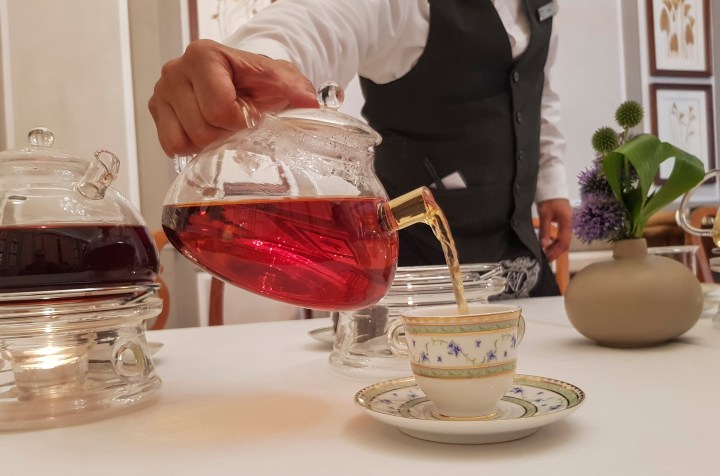
A tea tasting with tea sommelier Craig Cupido at the Mount Nelson Hotel, followed by a tea and dim sum pairing with Nigiro Tea Merchants’ Mingwei Tsai, reveal a world of tea that is about energy and connection as well as flavour.
Gewone or rooibos? I’ve lived in South Africa long enough to know that there are two basic types of tea to offer to guests. Even if I still don’t pronounce it in the correct Afrikaans fashion, gewone is “normal” tea, Five Roses black tea to be precise, and rooibos our South African bush tea, full of antioxidants, no caffeine, and no relation to the tea plant whatsoever. If we’re feeling posh we have Earl Grey on offer too.
So the loose leaf tea menu at Cape Town’s Belmond Mount Nelson Hotel was like opening a door into new territory, exciting but overwhelming – with 44 different teas and infusions to choose from, where do you even start? My mum treated us to afternoon tea during her recent visit, a fabulous feast proceeding through tiered cake stands of savouries and sandwiches, to scones with cream and strawberry jam, and then more arrangements of exquisite miniature cakes and patisserie.
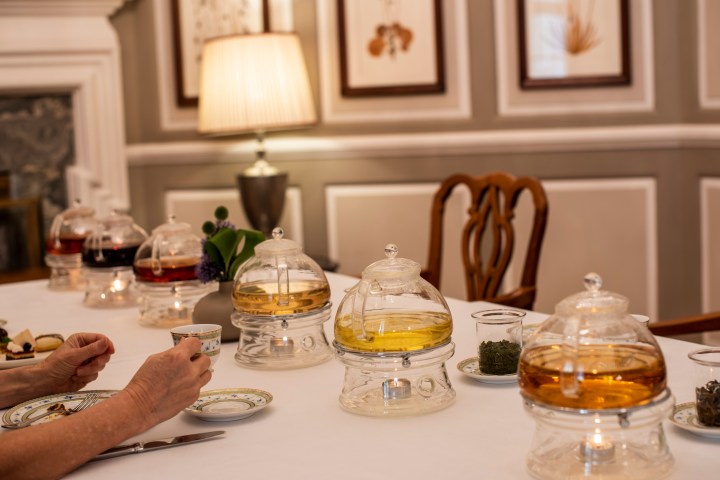
Tea tasting at the Belmond Mount Nelson. Glass teapots reveal the infinite shades of colour of different teas. (Photo: Patrick Heathcock)
After leafing through the 8-page tea menu we picked fairly much at random. Sky chose the appealingly named Gunpowder Temple of Heaven Chinese green tea. Never having heard of white tea, I went for White Monkey from China’s Fujian province. My mum selected a wonderfully aromatic scented oolong tea, Jasmine Bao Hao. Glass teapots of steaming water arrived on our table, placed on stands warmed by a tea light candle, the tea leaves still separate in glass infusers.
Our waitress did the honours, popping the infuser into the water at the right time and then telling us how long to leave it for. We sipped, enjoyed, feasted, tasted each other’s teas and chatted through a lovely afternoon until long after most other tea guests had left. Those sofas were just too comfortable. After drinking my whole pot of tea and a cup or two from the others I felt alert and clear-headed for the rest of the evening, on a tea high.
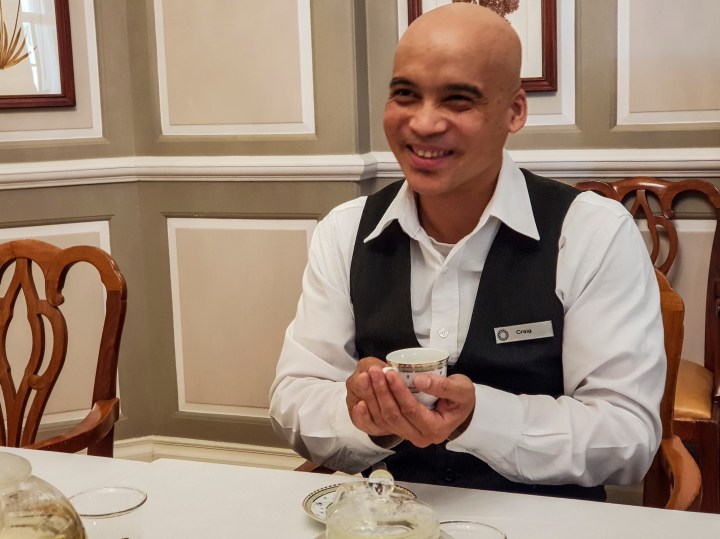
‘Drinking tea pulls you back towards yourself, to your centre,’ says tea sommelier, Craig Cupido. (Photo: Patrick Heathcock)
That was then. A few weeks later I return to the Mount Nelson seeking more knowledge from tea sommelier, Craig Cupido. He’s all abuzz from the breakfast coffee service when we greet each other, talking fast as he sets up a tasting of six different teas. Once the teas have brewed, he joins us in inhaling and sipping a subtle white tea. Calmness steals over him, his voice slows, and it feels like we have all the time in the world to chat, sip, absorb and share.
The energy of tea is very different from coffee, Craig says.
“Today everything is so rushed. A lot about coffee is masculine energy, that’s yang. We grind the beans, we put the steam through. We jump out of bed, get moving, grab our coffee, get a quick buzz of caffeine, that is how we resonate. Tea is different, tea is a feminine energy, yin. The combination of L-theanine (an amino acid in tea that has a relaxing effect) and caffeine gives you almost like a zen state, so it does this…”, he describes a long low plateauing curve with his hand. “It’s more subtle. Drinking tea pulls you back towards yourself, to your centre.” He adds later that monks would often use tea drinking to extend their meditation.
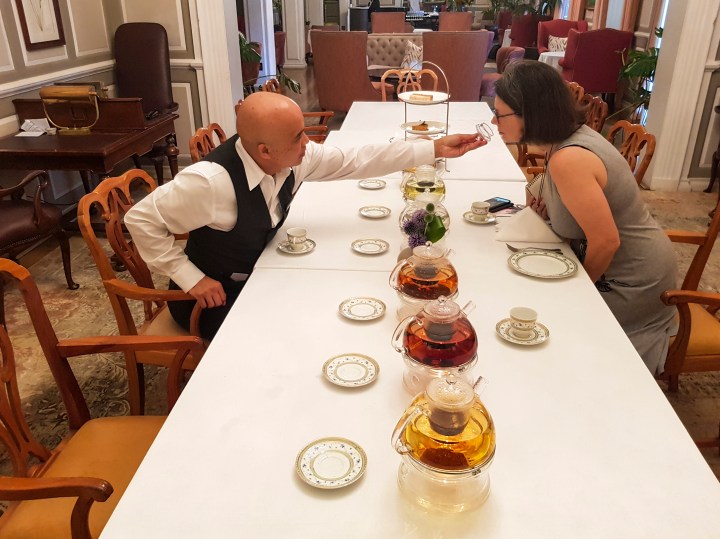
Colour and aroma are just as much part of the tea drinking experience as flavour, it’s all about connection. (Photo: Patrick Heathcock)
Although this isn’t a traditional tea ceremony, there is naturally something ceremonial about the preparation of tea. Craig goes along the row of six teapots, checking temperatures before putting in some of the tea leaf loaded infusers. Others wait a little longer. He is doing it by instinct, infusing each one for just long enough then removing the tea leaves to the side, they can always be returned to brew longer for a more intense flavour.
When I was a child the tea caddy was a fixture on the kitchen counter. A wooden box inlaid with marquetry, the lid lifted to reveal two compartments each with an inner wooden lid. On the left was loose leaf Darjeeling tea for breakfast. On the right a scented Chinese tea blend for the afternoon. I can remember smelling them to learn the difference and make sure I’d got the right one. By the age of nine or 10 I considered myself an expert tea maker. Warm the pot with tea from the kettle before it boils. Throw the water away once the chill was off the teapot, one spoon of tea per person and one for the pot, and then pour over the water while it was still on the boil. Lid on and brew for five minutes before pouring. Tea cups and saucers, never mugs. There may have been tea bags in the house, but I don’t remember my parents using them.
Now I learn that the insistence on having the water on the boil that I was taught back then isn’t the right treatment for many teas. For delicate scented teas, and green teas in particular, this is tantamount to abuse. That mouth-puckering bitterness people too often associate with green tea is a result of water that is too hot burning the leaves and drawing out the tannins to the detriment of the delicate flavour – “The temperature for green tea is low, 60-70°C – so you don’t get the tannins, and you also don’t destroy the antioxidants,” Craig tells us.
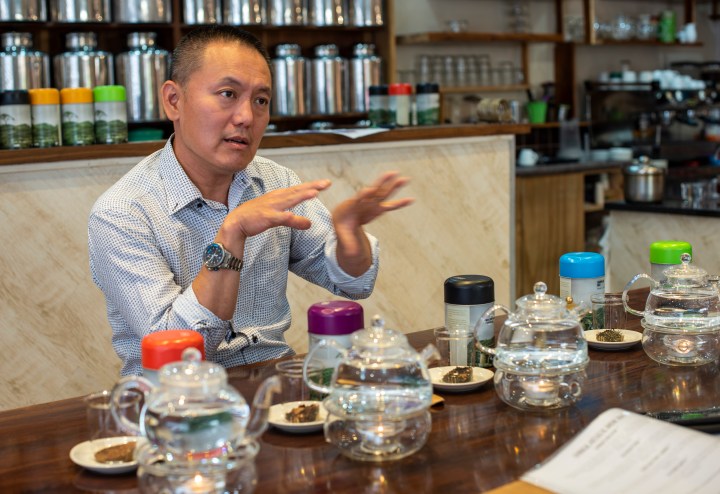
Mingwei Tsai shares his tea stories over a tea tasting and dim sum pairing at Nigiro Teacafe in Plumstead, Cape Town. (Photo: Patrick Heathcock)
Craig’s journey into tea came by chance. “I was delivering flowers to the father-in-law of Mingwei Tsai, who owns Nigiro Tea Merchants, and because he likes to get to know people he introduced me to a tea ceremony. I was like, what is this? I had no idea what the difference was between green tea and oolong and black. My tea came in a teabag. I did a few deliveries for him and he started introducing me to tea. I was really interested in learning more.” Craig joined Nigiro and learned the lore of tea and tea-making, then years later when the Mount Nelson was looking for a specialist tea sommelier he moved here.
He’s guided us through a white tea, very delicate and a good palate cleanser, made from the buds of the tea plant before they’ve opened to the sun. Then a Japanese green tea, “Japanese green tea is grassy, seaweedy, basically a description of sushi,” he tells us. “Chinese green tea is nutty, woody, floral, sometimes toasty. The Japanese steam their tea to stop the oxidation process, whereas the Chinese revere smoky wok flavours, and they wok fry their tea, so the processes they each use for their tea mean it pairs nicely with their food.”
Next is the extravagantly named Jasmine Dragon Phoenix Pearls, a limited production tea that demonstrates how much of tea’s character and quality is down to the dedication of the farmers. Oolong tea leaf tips are sprinkled with thousands of fresh jasmine petals and left to infuse over 20 days, changing the petals perhaps seven times until the tea has captured the fragrance. The petals are discarded and the tea leaves are hand-rolled into small pearls to lock in the aroma. As we sip and inhale, appreciating the delicate perfume even more now we know what went into making it, Craig exclaims “Isn’t she beautiful!” and then “Can you see how many different tea personalities we have here. There are thousands to explore.”
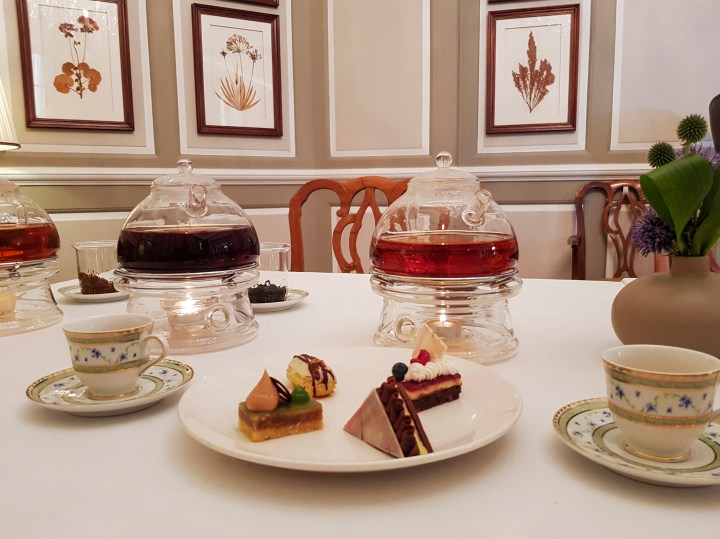
The Mount Nelson Hotel blend of six black teas from African and Asia flavoured with rose petals pairs well with chocolate and the exquisite miniature cakes served at afternoon tea. (Photo: Patrick Heathcock)
This is why you shouldn’t add milk and sugar when you’re drinking proper loose leaf tea, the delicate personalities of the teas get lost. And when brewed correctly they don’t need anything added. However, Craig says, if someone really wants milk in their tea he’ll add a little more Assam to the Mount Nelson Hotel special blend, which combines six prime black teas from different tea growing countries and rose petals, to give it enough depth and body to balance the milk. This is an excellent tea to go with the sweet course of the afternoon tea, he adds, pairing nicely with anything chocolatey.
Before we taste the dark brown Pu-erh, Craig asks us if we like whisky. It’s an acquired taste, he says, very earthy and peaty, having gone through a full fermentation process, and is full of probiotics. We do like whiskey and enjoy the peatiness, which gets more pronounced the longer it brews, until it can become pitch black. He suggests we pair it with the mushroom empanada that is one of the delicious afternoon tea savouries.
Finally a rooibos tea flavoured with warm cinnamon, cardamom, cloves, a good pairing for the mini bobotie. We’re so relaxed by now that we could carry on chatting and tasting for hours, but Craig has to leave us as the first afternoon tea guests are arriving. Tea tastings like this are only by special arrangement currently, but if you book for an afternoon tea and ask for Craig or Daryl, the two tea sommeliers enjoy nothing more than sharing their knowledge and love of fine tea, tailoring your tea experience especially for you.
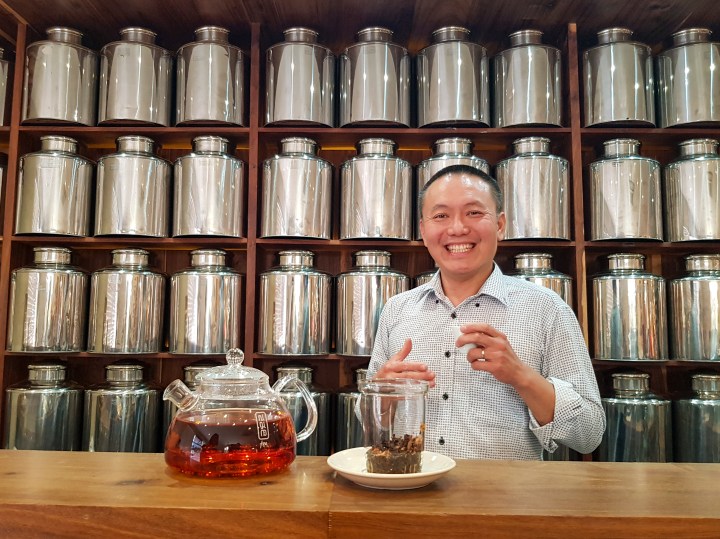
Mingwei Tsai in front of a small section of his ‘library’ of 580 teas and blends at Nigiro Teacafe. (Photo: Patrick Heathcock)
A week later on a sultry, overcast day, we follow our tea to its Cape Town source. Nigiro Tea Merchants supply teas to many of the top hotels in Cape Town and countrywide, and owner Mingwei Tsai has trained over 3000 staff and tea sommeliers in correct tea making and service over the years. His wife Lisa runs Nigiro Teacafe in Plumstead (it moved here last year from Claremont, where it was called O’ways.) The café is friendly and informal, a secluded haven off the main road with easy parking outside, where you can savour a perfect pot of tea along with delicious vegetarian and vegan Asian snacks, breakfasts and lunches, and shop the vast range of teas and tea-making paraphernalia.
We’ve come for a tea and dim sum pairing guided by Mingwei. He has chosen five different teas for us that will go with the food – what he chooses one day, he says might be completely different the next, it’s all about what feels right. I’d expected something purist, educational, perhaps even austere, from this the fount of all tea knowledge in South Africa. But the teas he’s chosen for me today are full of joie de vivre – Japanese green tea with strawberry and lemon; Bai Hao jasmine tea; a black tea with cocoa husk, rose and vanilla; hibiscus tea with cranberry and raspberry; and a marula and strawberry rooibos. All of these he blends himself.
“Tea drinking and the passion behind tea is a little bit different,” Mingwei tells me. “The energy associated with tea is different to that of coffee or wine or beer. It’s not a very expressive energy – you don’t have to make a big hoo-ha about it. Making a big thing doesn’t get you to drink more tea. Saying less doesn’t mean you say nothing.”
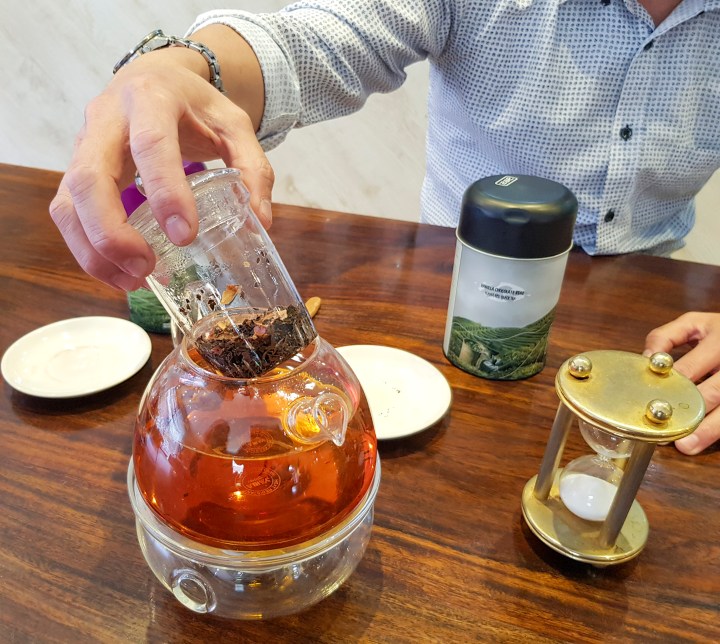
An hourglass timer helps keep track of the infusion time, but Mingwei seems to decide by instinct when each tea is ready. (Photo: Patrick Heathcock)
We’re back at that calm, connected energy again, something I’m beginning to love about drinking tea. Conversation with pauses. So little hurry that time often seems to be standing still. Everything at its own pace as the tea brews.
Mingwei carefully introduces each tea into its pot of water and we discuss the low temperature required for green tea – never ever boiling water. “People often associate green tea with being bitter and they think that bitter green tea is good for you. I don’t know how they come up with that, it’s completely inaccurate – it’s supposed to be grassy, nutty, it’s supposed to be a food with different waves of flavours, and bitterness is not part of the flavour profile.” This is something he obviously feels strongly about, but he laughs about it too, “In Asia using boiling water on green tea is very disrespectful. It’s saying to the tea drinker, ‘I don’t like you, and please go home’. It’s a very bad insult – you only do it if you really dislike a person and you have no guts to tell them face to face.”
I ask Mingwei about the sense of alertness I experienced after our afternoon of tea-drinking at the Mount Nelson. “In terms of caffeine content, one cup of coffee is equivalent to 15-20 cups of green tea, 3-5 cups of black tea. By the time you’ve finished 15 cups your blood circulation is going to be so enhanced that you’re not going to be affected by the caffeine. But the caffeine in tea is coupled with vitamins and minerals released slowly into water, unlike coffee which has a lot of caffeine and never in proportion to the vitamins and minerals.” He reflects a moment, “The buzz could come from the energy from the tea. When they harvest the very top of the tea plant for green tea, it has a lot of energy inside it, that energy may make you feel very alert. For example one scoop of oolong tea is the equivalent to 5-10 tea plants growing slowly over 2-3 months in the high mountains, so what you are drinking is the consolidation of the vitality and energy of all these shoots.” I love that explanation. He goes on to point out how much more flavour a tomato has when grown slowly in sunshine in your back garden, compared to one grown with artificial fertilisers in a tunnel, pushed to grow, ripen and harvest unnaturally quickly.
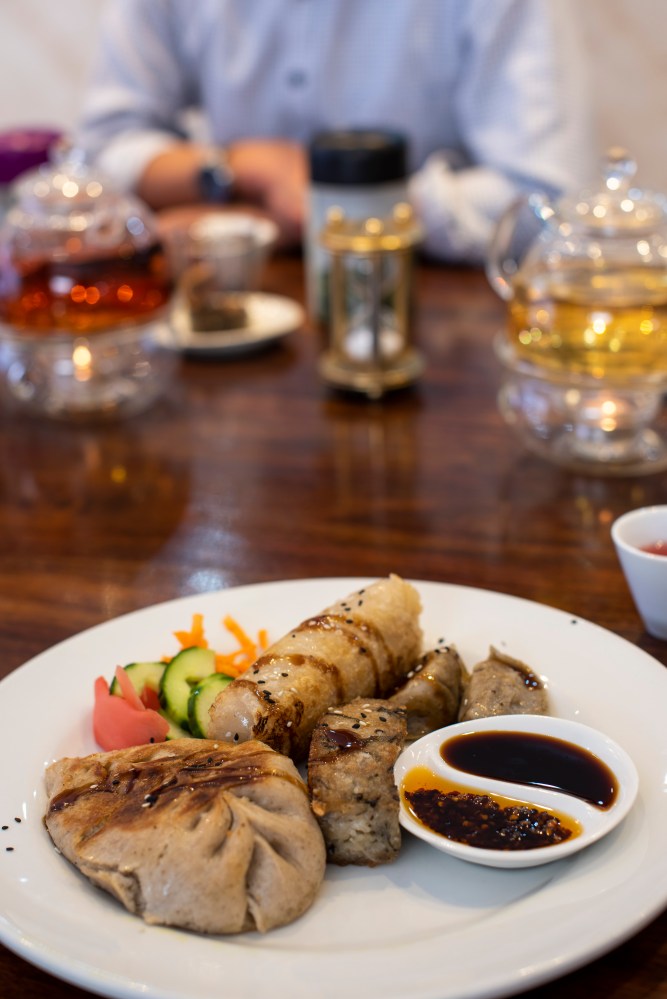
Honeybush dumpling bao sticky seaweed rice and green tea har gau potstickers, our dim sum platter with chilli oil and teriyaki dips to pair with a selection of teas. (Photo: Patrick Heathcock)
As we start to taste the teas, while waiting for the dim sum to arrive, Mingwei elaborates on the qualities experienced with different teas. Black tea is earthy and grounding, green tea is lively and full of vitality. Oolong bridges the two, he says. The first infusion of oolong in the tea pot experiences the world of the green tea, a second infusion gives you the experience of the black tea. And hibiscus, which like rooibos isn’t technically a tea, is very good for digestion and regulating blood pressure. “But you know, I believe that tea drinking – a person is not going to enjoy tea if he is only basing it on the health benefits of tea. Sit under a tree and smell the tea, taste the tea. As long as a connection is made it’s good.”
Tea making and drinking is something Mingwei has always enjoyed. Originally from Taiwan, he came to South Africa aged 13 to study, intending to become an engineer, and was working on his PhD in civil engineering when tea took over. “I went to the UCT societies sub-council and said I would like to start a tea club. The guy looked at me, called a friend from inside and asked me to repeat it. I said I want to start a tea club for UCT. Both of them laughed like crazy, looked at each other and said, “But we have a beer club”. So that was the beginning and the end of the UCT tea club.” He successfully started a tea club outside UCT and eventually joined Origin Coffee in 2008 to expand their tea division, which they called Nigiro. The name is Origin written backwards, a nod to the yin and yang nature of tea and coffee. Initially one business, they have since separated into supportive sister companies, and over the years Mingwei has dramatically expanded South Africa’s tea drinking horizons to world class levels, selecting and importing the finest teas from around the world. “When people laugh at you, you either pack your bags and go, or you just change direction,” he says. “I enjoy tea making, I enjoy tea ceremonies. I enjoy drinking tea with old people and hearing their stories. I enjoy sharing stories with people.” This is what tea is all about, the stories and the sharing, slowing down and making a connection.
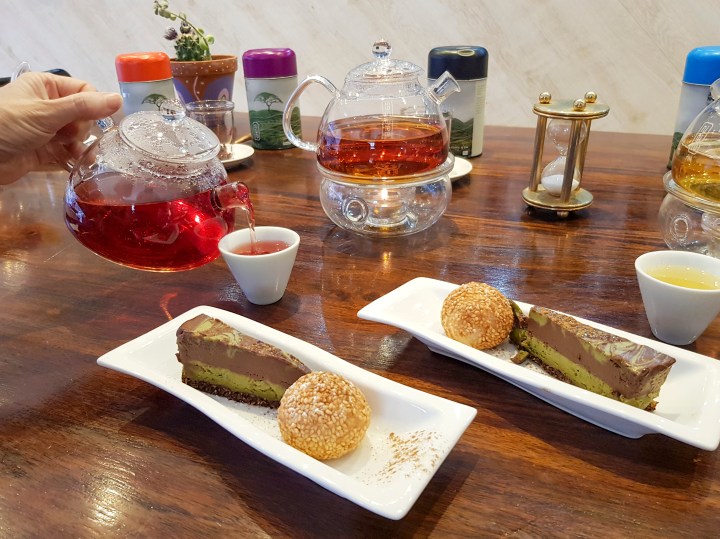
For dessert, the fruity hibiscus blend pairs well with a delightfully chewy sesame peanut ball. The vegan chocolate mint tart pairs best with the lemon and strawberry green tea. (Photo: Patrick Heathcock)
Tea has for a long time been the quieter sibling in the shadow of the more extrovert coffee, but as people get more interested in the stories behind ingredients and food, and chefs start focussing on those stories, tea is coming into its own again – after all tea has a never-ending compendium of stories to tell if you take the time to listen. Mingwei is seeing more demand from hotels, restaurants and boutique establishments for exclusive tea blends created especially for them, and for staff training. “If you go to a fine establishment you want to understand the stories behind it and drink a tea that has a connection with it. Some places are happy to spend money on the soap in the toilet, but then they serve Five Roses and Freshpak. It requires a tea drinker – most tea people are quite calm and humble – to politely point out that good tea completes the service.”
Our dim sum platters from the tea-inspired, vegetarian café menu have arrived now. We taste seaweed sticky rice, the creaminess of the rice almost caramelised, pairing nicely with both the jasmine tea and the black tea with vanilla and chocolate. That tea is a revelation, rich cocoa flavour from Ethiopian cocoa husks supported by black tea earthiness. And I’m now a convert to jasmine tea – stopping to smell and sip the flowers feels like my kind of self-care ritual. My husband meanwhile is enjoying the freshness of green tea with lemon and hints of strawberry, paired with a vermicelli spring roll filled with vegetables and tofu. We share a pan-fried honeybush dumpling bao and then umami Har Gau potstickers, the dough flavoured with green tea powder filled with shitake mushrooms and marinated soy mince. The dim sum are delicious and substantial, the teas light and fragrant, a match made in tea heaven.
That feeling of time slowing down, of becoming more centred and clear-headed, of a conversation that you could carry on for hours, is tea’s gift to us, invaluable in this stressed out, fast-paced world, and something I want to hold on to now that I’ve discovered it. The choice between gewone or rooibos tea bag tea no longer feels like it does justice to the world of tea possibilities out there, lacking the sense of connection and relaxed joy that real teas bring to the conversation. DM/TGIFood
Explore Nigiro’s huge range of teas. More about afternoon tea at the Mount Nelson.
Follow Kit Heathcock on Instagram @kitheathcock
The writer supports Gift of the Givers working on disaster response, provision of clean water, hunger alleviation and many other projects in South Africa and around the world.




 Become an Insider
Become an Insider
Comments - Please login in order to comment.